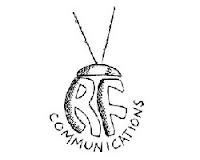RF COMMUNICATION
What is RF Communication?
RF -Radio Frequency communication. It is a wireless communication.
It makes use of Electromagnetic waves that is available in the free space for its communication.
The biggest advantage of RF communication is that it does not have Line of Sight. (No need of Transmitter and Receiver to be in straight line)
Like all other communication it also has source, medium and destination.
The Radio Transmitter is the source, Radio Receiver is the destination and the Free Space is the medium through which the electromagnetic wave travels.
In free space, there is more probability of message signal to get mixed with noise.
In order to avoid the mixing up of noise the message signal is modulated with a carrier signal in the transmitter end.
Again in the receiver end the reverse process takes place i.e. the original message signal is recovered by demodulation.
It makes use of Electromagnetic waves that is available in the free space for its communication.
The biggest advantage of RF communication is that it does not have Line of Sight. (No need of Transmitter and Receiver to be in straight line)
Like all other communication it also has source, medium and destination.
The Radio Transmitter is the source, Radio Receiver is the destination and the Free Space is the medium through which the electromagnetic wave travels.
In free space, there is more probability of message signal to get mixed with noise.
In order to avoid the mixing up of noise the message signal is modulated with a carrier signal in the transmitter end.
Again in the receiver end the reverse process takes place i.e. the original message signal is recovered by demodulation.
MODULATION:
The
message signal is normally low frequency signal it cannot travel longer
distance also have high chance of mixing up with noise.
To make the message signal travel longer distance without interruption it is modulated with high frequency signal called carrier signal.
The process of changing the characteristics of carrier signal with respect to the message signal is called modulation.
It is done in the transmitter.
To make the message signal travel longer distance without interruption it is modulated with high frequency signal called carrier signal.
The process of changing the characteristics of carrier signal with respect to the message signal is called modulation.
It is done in the transmitter.
DEMODULATION:
The process of recovering the message signal from the modulated signal is called demodulation.
It is done in the receiver.
It is done in the receiver.
TYPES OF MODULATION:
Amplitude Modulation:
The process of changing the amplitude of the carrier signal with
respect to the amplitude of the message signal is called Amplitude
Modulation.
Frequency Modulation: The process of changing the frequency of the carrier signal with respect to the frequency of the message signal is called Frequency Modulation.
Phase Modulation: The process of changing the phase of the carrier signal with respect to the phase of the message signal is called Phase Modulation.
Frequency Modulation: The process of changing the frequency of the carrier signal with respect to the frequency of the message signal is called Frequency Modulation.
Phase Modulation: The process of changing the phase of the carrier signal with respect to the phase of the message signal is called Phase Modulation.
Radio Transmitter:
Before transmitting data it is encoded for safety transmission by encoder.
The transmitter contains modulator, amplifier and antenna.
The message that has to be transmitted is modulated and transmitted by means of the antenna.
The modulated signal is amplified to make it travel for long distance.
The transmitter contains modulator, amplifier and antenna.
The message that has to be transmitted is modulated and transmitted by means of the antenna.
The modulated signal is amplified to make it travel for long distance.
Radio Receiver:
The receiver contains antenna, amplifier and demodulator.
The transmitted signal is received by the antenna.
Even though the message signal is amplified and then transmitted the signal received in the receiver side is very low hence it is amplified once again.
The amplified signal is demodulated by the demodulator.
The encoded data is decoded here in the decoder unit.
NOTE: The modulator and demodulator should have same carrier for getting correct message signal.
The transmitted signal is received by the antenna.
Even though the message signal is amplified and then transmitted the signal received in the receiver side is very low hence it is amplified once again.
The amplified signal is demodulated by the demodulator.
The encoded data is decoded here in the decoder unit.
NOTE: The modulator and demodulator should have same carrier for getting correct message signal.















